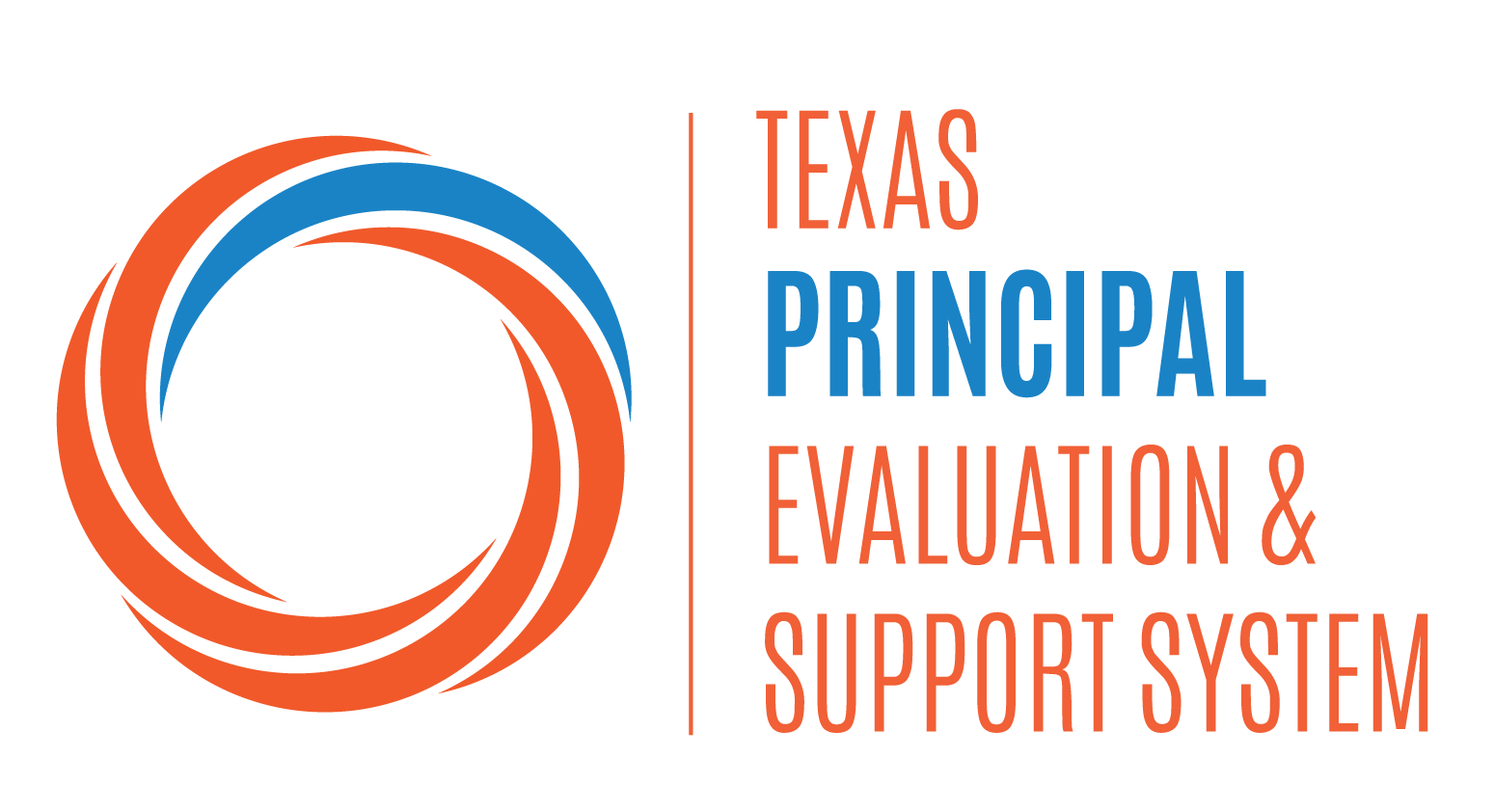Completing T-PESS
T-PESS was designed to give principals meaningful and manageable guidance as they chart their own course for professional growth and development, ultimately benefitting student success in their schools. On this page, you'll learn about the steps you and the principal will take over the course of the school year, including T-PESS training and orientation, completing a self-assessment, composing a professional development plan, and setting improvement goals.
Training
Before initiating the T-PESS process, every educator without prior experience using T-PESS will have the opportunity to receive training. TEA utilizes a system of regional education service centers to provide the training and support necessary to make T-PESS meaningful, manageable, and productive. You've been selected, along with a key group of professional staff, to receive facilitator training, undergo quality assurance, and be authorized to deliver T-PESS to school districts in your geographic region.
This system of support and the required training process helps to ensure that everyone has the same procedural knowledge to effectively use T-PESS and apply the evaluation process. We believe that well-trained and knowledgeable users help protect the reliability of the rubric and system, making it more likely that the results of the evaluation will be authentic.

Orientation
Before your annual evaluation, you'll go through an orientation session, which can be conducted as a large group session, in smaller group settings, or individually, depending on your school district's calendar.
Orientation is an important step in the process because it does all of the following:
- Provides you and the principal with concise and accurate information regarding T-PESS
- Ensures that you and the principal understand your roles and responsibilities
- Details the T-PESS process and provides a specific timeline for when required activities are due
- Communicates any regulations and policies that govern principal evaluations
- Covers how performance will be measured

Self-Assessment and Goal Setting
The self-assessment will help facilitate collaborative conversations between you and the principal as you share and develop a common understanding of professional practice and performance expectations. It is not to be used in making final judgments about performance nor to convince one another of particular performance ratings.
Self-Assessment is a powerful technique for improving performance because it provides the opportunity for you to consider past feedback you've received from peers/appraisers and how your current practice fulfills the Texas Principal Standards and evaluation rubric. Ross and Bruce (2005) provide several primary advantages resulting from using self-assessments in principal/teacher performance:
- You are able to clarify your definition of excellence. Since the rubric provides a scaffolding of knowledge and skills, you can identify specific practices on which to compare your performance against expected performance measures.
- You can identify discrepancies between actual and desired performance.
- You can more easily set improvement goals based on clear standards of leadership. It is within this analysis and ongoing conversation that immediate and realistic goals can be supported throughout the evaluation cycle.
- You gain a common language for discussing instruction, district-adopted models of professional practice, and the various levels of performance associated with the rating scale.
Completing the Assessment
Engaging in and completing the Self-Assessment is time well spent. Typically, this process takes 15 to 30 minutes. Before beginning, it's smart to reflect on your past performance and reviews. This will help you determine your knowledge of the T-PESS leadership practices and your current level of performance for each one.
You will use the T-PESS rubric and the T-PESS Principal Guide to complete your Self-Assessment to reflect on and benchmark your performance. The procedure to complete the self-assessment is below.
- Begin with Domain 1, Indicator 1.1.
- Start with the "Developing" rating column. Mark the descriptors for which you have evidence that you perform consistently well.
- Repeat the process through the "Distinguished" column.
- If you can't confidently make any marks throughout the indicator, write a brief comment in the "Needs Improvement" box that will remind you to discuss this particular indicator with your appraiser.
- Replicate this process for each of the domains and supporting indicators.
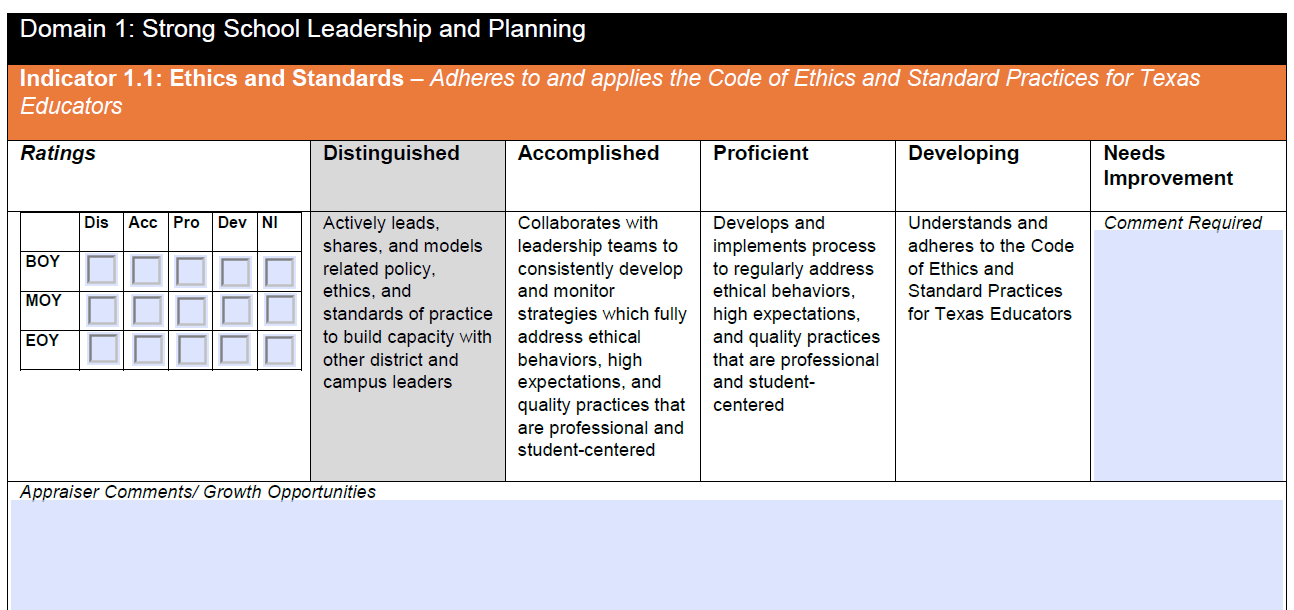
- Begin in the "Developing" column.
- Mark the descriptors you believe you know and perform consistently well.
- Repeat the process through the "Distinguished" column.
You might want to use a learning taxonomy to help you make an accurate and reflective analysis of your performance (McREL, 2005). Consider the following as you read through and mark descriptors:
- What you know about the knowledge, skills, and dispositions implied about the descriptor (Declarative Knowledge)
- How you specifically meet the expectations of that descriptor (Procedural Knowledge) and what artifacts and evidence would substantiate your performance
- When you have applied the skills and strategies inferred about the descriptor (Contextual Knowledge)
- Why the skills and knowledge inferred about the descriptor are important for student success (Experiential Knowledge)
While a minimum of one complete self-assessment is required at or near the beginning of the school calendar year, it's a good practice to complete periodic self-assessments throughout the year to reinforce performance expectations and keep improvement at the forefront of your appraisal conversations.

Professional Development Plan
The professional development plan is an essential part of your evaluation process (McGreal, 1983). Goal setting, progress monitoring, and goal attainment, as part of professional development planning, is the continuous process of acquiring and refining the skills necessary to execute practices that improve student achievement. Planning and goal setting focuses you and your supervisors on improving and refining practice (Dean, Stone, Hubbell, & Pitler, 2012). To complete the professional development planning process requires a collaborative effort between you and the appraiser to monitor goal progress and eventually determine goal attainment.
The T-PESS Professional Development Plan constitutes three main parts:
- Beginning-of-Year: Goal Setting
- Mid-Year: Progress Toward Goal Attainment
- End-of-Year: Goal Attainment
Throughout the course of the evaluation cycle, your advisor should monitor, evaluate, and provide constructive feedback on the progress and attainment of your individual performance goals. However, crucial points during the year, such as during the professional developments plan's creation, the Mid-Year Conference, and the End-of-Year Performance Discussion, will also provide opportunities to formally address your progress and adjust your strategy, as needed.
Goal Setting
When using the rubric to self-assess at the beginning of the year, you should gain a clear idea of the highest-priority areas on which to base your improvement goals (Marshall, 2009; Ross & Bruce, 2005). Goals will be easier to achieve if they are based on an authentic self-assessment with unambiguous outcomes that are moderately difficult, yet achievable in the near future. The result of the self-assessment is one data point on which to identify goal opportunities. Other data sources on which to base improvement goals should come from campus improvement plans, district strategies and priorities, and past feedback from peers and appraisers.
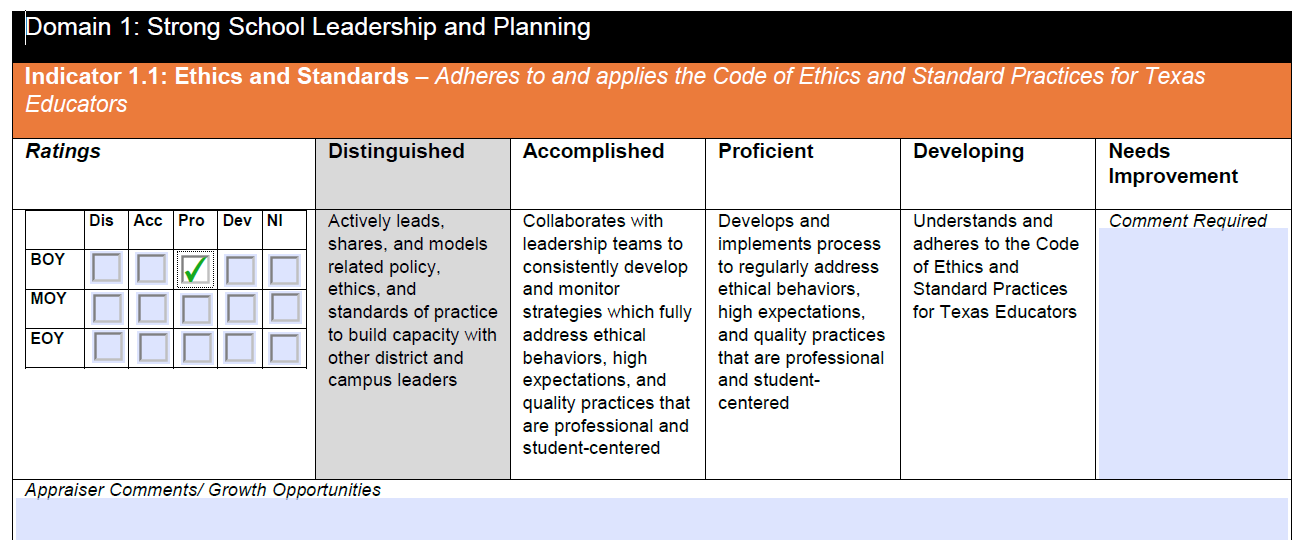
It is strongly encouraged to set improvement goals using the SMART (O'Neill, et.al, 2006) criteria. The acronym, SMART, embodies the fundamental practices necessary for achieving increased motivation and improving the odds that you will actually accomplish your set of goals. The Goal Setting Form is designed in such a way as to emphasize setting goals using the SMART criteria:
- Specific - Target a specific area for improvement.
- Measurable - Quantify or at least suggest an indicator of progress.
- Assignable - Specify who will do it.
- Realistic - State what results can realistically be achieved given available resources.
- Time-related - Specify when the result(s) can be achieved.
A goal can focus directly on part of a campus improvement plan, a district strategic priority, or a plan to improve a specific leadership practice or competency. An example of a campus improvement goal may read, "Implement the Cool Reading Program during the 2020 school year in all language arts classrooms in grade 9 to reduce the literacy gap between sub-populations of students as measured by the end-of-course exam." An example of a goal related to a district priority may read, "Evaluate the implementation of the district-approved mathematics curriculum for the 2020 school year to ensure all students have access and teachers have the time to teach the curriculum." An example of a goal to improve a specific leadership practice might read, "Improve the quality contacts and interactions with teachers and students for the 2020 school year as measured by the Teacher Working Conditions Survey and Student Engagement Survey." Regardless of the focus, determining the goal will require you and the appraiser to consider the following:
- Texas Leadership Standards and indicators that will be addressed by the goal
- Strategies and actions the principal will engage in to accomplish the goal
- Expected measurable outcomes. (In other words, how will we measure goal progress and ultimately goal attainment? What artifacts and evidence will need to be produced to demonstrate goal process and goal attainment?)
- Specific timeline for benchmarks and milestones related to goal progress and attainment
- Reasonable resources that may be required to accomplish the goal
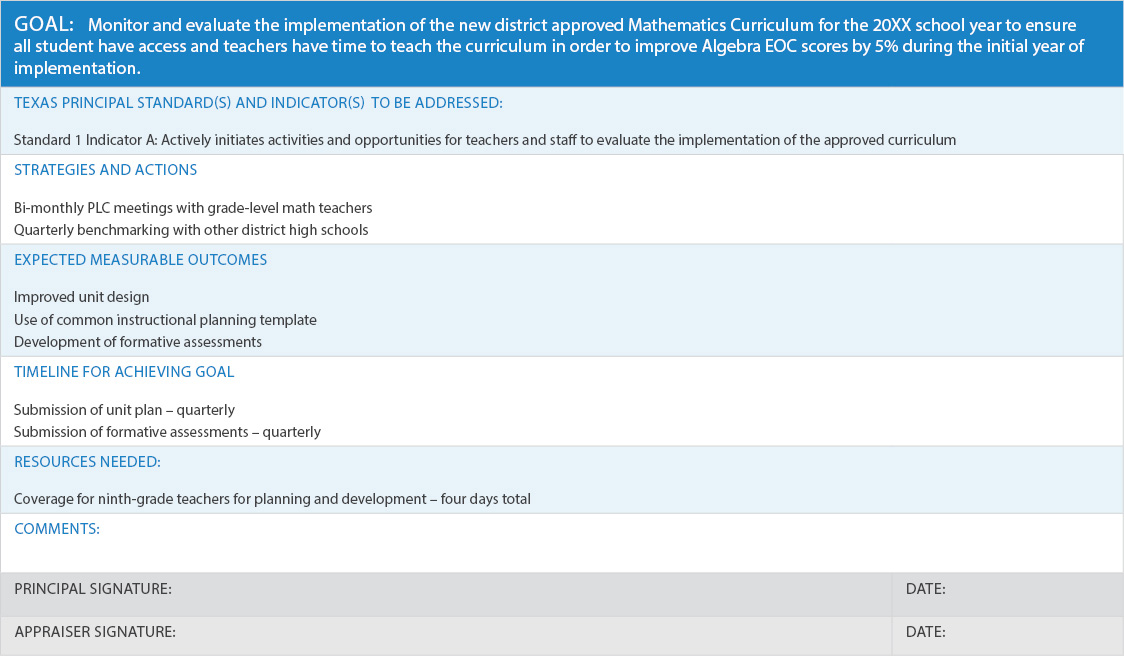

Beginning-of-Year Goal Setting / Refinement Conference
The Beginning-of-Year Goal Setting / Refinement Conference provides you and the appraiser the opportunity to engage in collaborative conversations. At this meeting, you and the appraiser will discuss your Self-Assessment and the most recent draft of the professional development plan. The primary purpose of this conference is to give you both the opportunity to discuss professional practice in relation to the five principal standards.
In preparation for the Beginning-of-Year Goal Setting / Refinement Conference, you should do the following:
- Submit a copy of your completed Self-Assessment.
- Submit a draft of your professional development plan.
In preparation, your appraiser will do the following:
- Review the results of your Self-Assessment and previous year's summary ratings.
- Review your draft professional development plan.
During this meeting, it is recommended that you and the appraiser do the following:
- Discuss your practice in relation to your Self-Assessment and summary ratings from the previous year's evaluation. This dialogue is not intended for you and the appraiser to debate the results of the Self-Assessment, but rather discuss learning as it applies to district-adopted models of professional practice and the Texas Principal Standards.
-
Finalize the professional development plan as follows:
- Review the elements and/or standards to be addressed
- Clarify the types and sources of artifacts and evidence to support performance
- Review any state or local policy that may pertain to the professional development and evaluation of principals
- Sign and date the professional development plan

Data Collection
You will collect the data agreed upon at the Beginning-of-Year Goal Setting / Refinement Conference throughout the evaluation cycle. These data may include the artifacts listed for each standard on the rubric; feedback from parents, students, and the school community; documentation of professional development completed during the year; and other data to document your achievement of performance goals. The frequency, duration, and type of data collected are generally determined by local policy and negotiated agreement. The appraiser will visit your school during this period in order to observe the environment and interact with teachers and other members of the school community.

Mid-Year Conference
The Mid-Year: Progress toward Goal Attainment form and the Mid-Year Conference provide the opportunity for you and your appraisers to formally take stock of the progress you are making toward your professional goals and to modify goals if needed. This conference should be held near the mid-point of the annual evaluation cycle, roughly the second week of December; however, district policy and timelines will determine a specific due date.
Your appraiser should monitor and provide feedback regarding the progress toward achieving your goals and provide a brief narrative for each goal established in the professional development plan. Signatures are required to complete the Mid-Year: Progress toward Goal Attainment form.
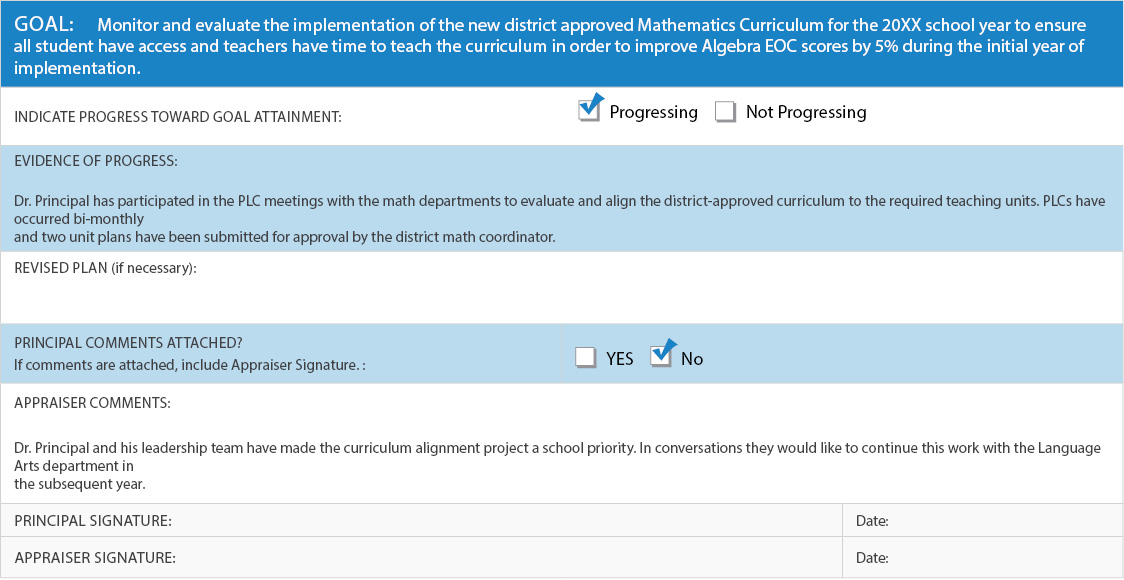
Preparation by the evaluator prior to this conference is important. The appraiser should do the following:
- Review your self-assessment and professional goals
- Consider the evidence collected through site visits
- Review and consider the depth and quality of the artifacts submitted or collected

Artifacts and Evidence Identification and Collection
In preparation for the End-of-Year Conference and final Summary Evaluation Ratings, it is important for you to prepare information in advance. You should review your performance goals and mid-year progress and consolidate the artifacts and data you've collected so far. This information should be sent to the appraiser in advance of the final meeting to allow him or her time to adequately prepare.

End-of-Year Conference
Your appraiser should help you make the most of your End-of-Year Performance Discussion by carefully considering the key messages to be discussed, the ratings you will receive on each of the standards, and anecdotal evidence detailed in your goals. If the appraiser has been communicating regularly and candidly with you all year, the final ratings and goal attainment determination should contain no surprises.
End-of-Year Progress: Goal Attainment
T-PESS was built to monitor goal progress as an ongoing process. When done on a frequent basis, it should offer you a chance to see how you are progressing. It also provides the opportunity to reflect on the leadership practices emphasized to accomplish the goal. Second, progress monitoring offers the opportunity for you and the appraiser to discuss and clarify leadership practices within the context of your school using real data. Lastly, determining goal attainment at the end of the annual evaluation cycle will factor in to your overall performance rating.
After completion of the Summary Rating form, the appraiser will use the End-of-Year: Goal Attainment form to determine if you accomplished your improvement goals detailed in the Professional Development Plan from the beginning of the school year. This form is a formative rubric that offers both of you the opportunity to dialogue about the depth and degree to which you accomplished your goals. Often, educational goals can exceed the limit of a school year and may need to carry over to subsequent years. The appraiser then uses the End-of-Year Progress form to provide a brief narrative of the outcomes related to goal attainment and obtain the appropriate signatures.
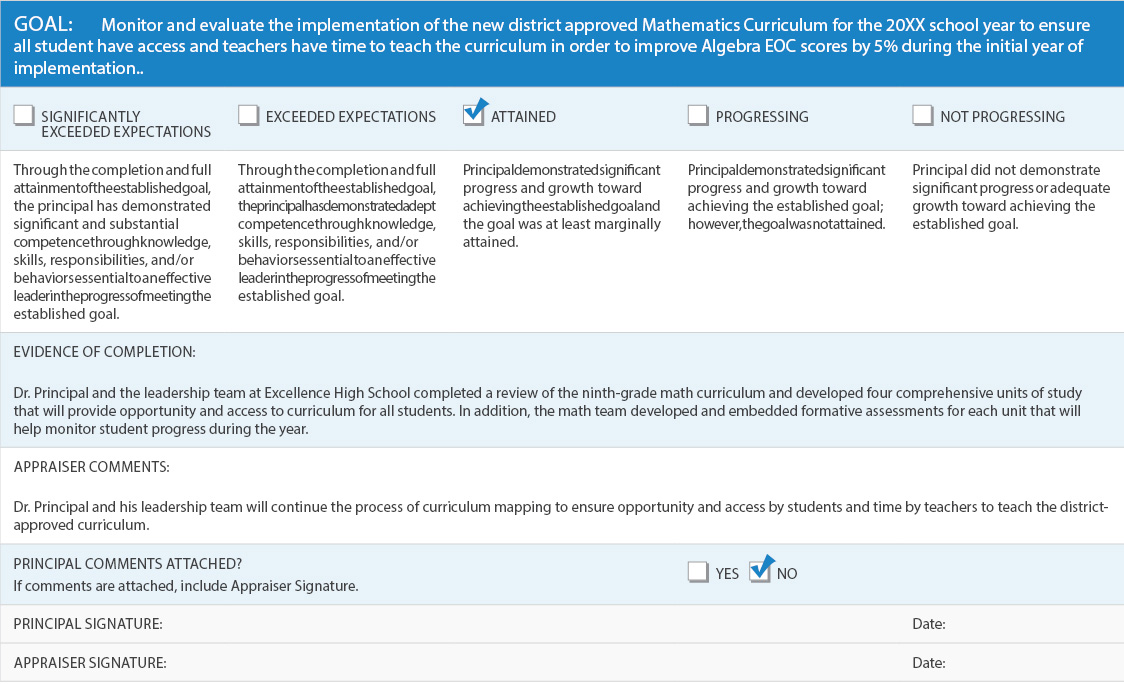
End-of-Year Final & Summary Ratings
Your final rating will be based on the data collected from all site visits and artifacts for the year, as well as any other evidence that may be required by your school district.
To receive a specific rating for an indicator, you must have received at least one check during the course of the evaluation cycle on all the descriptors in that category and the previous category. If you do not meet the minimum requirements, those skills will be considered Needs Improvement, and your appraiser will need to explain the reason for the rating.
Your appraiser will also derive summary ratings from the quantitative, qualitative, and anecdotal data collected throughout the year, including all data from the Artifacts and Evidence Identification and Collection.
Completing the Summary Rating form, your appraiser will do the following:
- Give a rating for each indicator contained in the standards.
- Make a written comment on any indicator marked "Needs Improvement."
- Give an overall rating for each standard based on the indicator ratings.
- Provide you with the opportunity to add comments and/or attach written comments to the Summary Rating form.
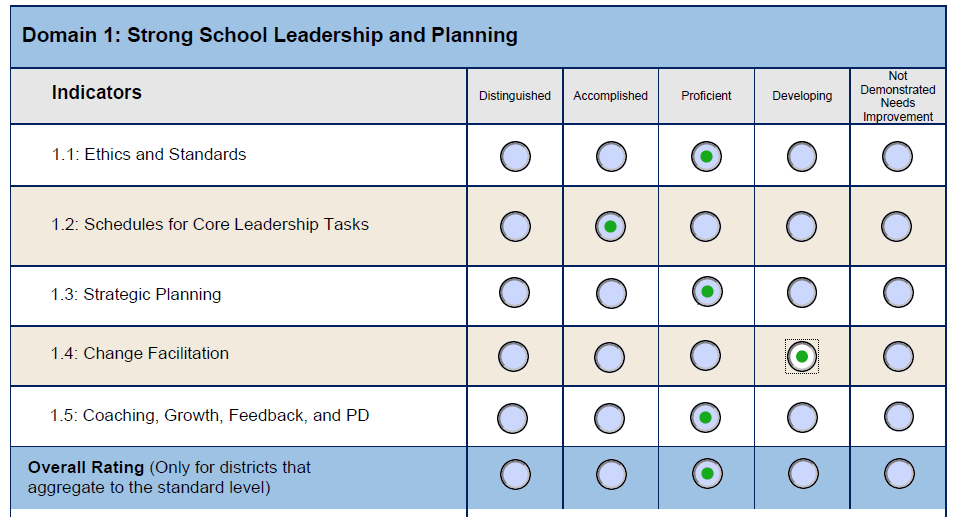
Final Evaluation and Goal Setting
Once your appraiser has completed the Summary Rating and End-of-Year Progress forms, he or she will schedule a final conference with you. This meeting provides the opportunity to discuss your performance and complete the final procedures for the evaluation cycle. It will also bring closure to the current year's evaluation and begin the process of setting goals for next year!
At a minimum, you'll do the following in this conference:
- Review the completed Summary Rating form and your progress toward your improvement goals
- Sign the Summary Rating form and Record of Principal Evaluation Activities form
